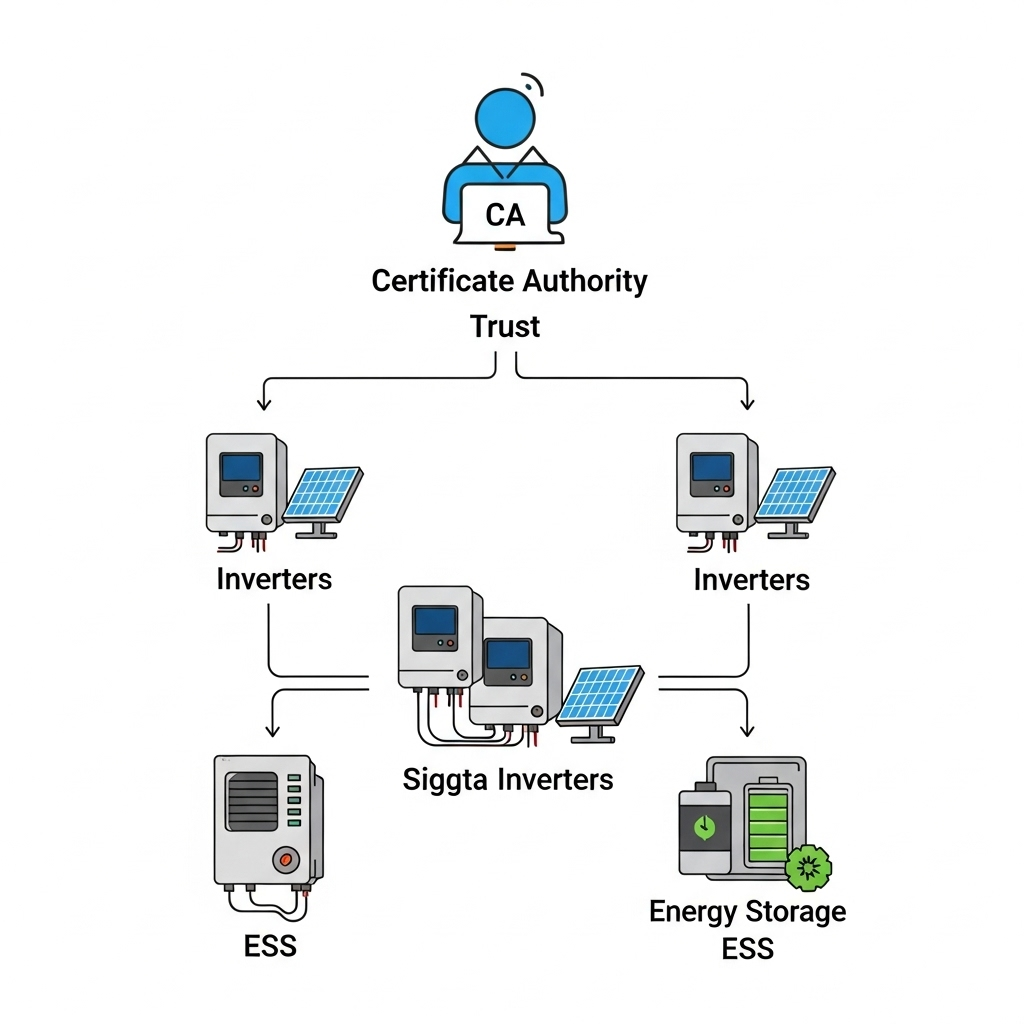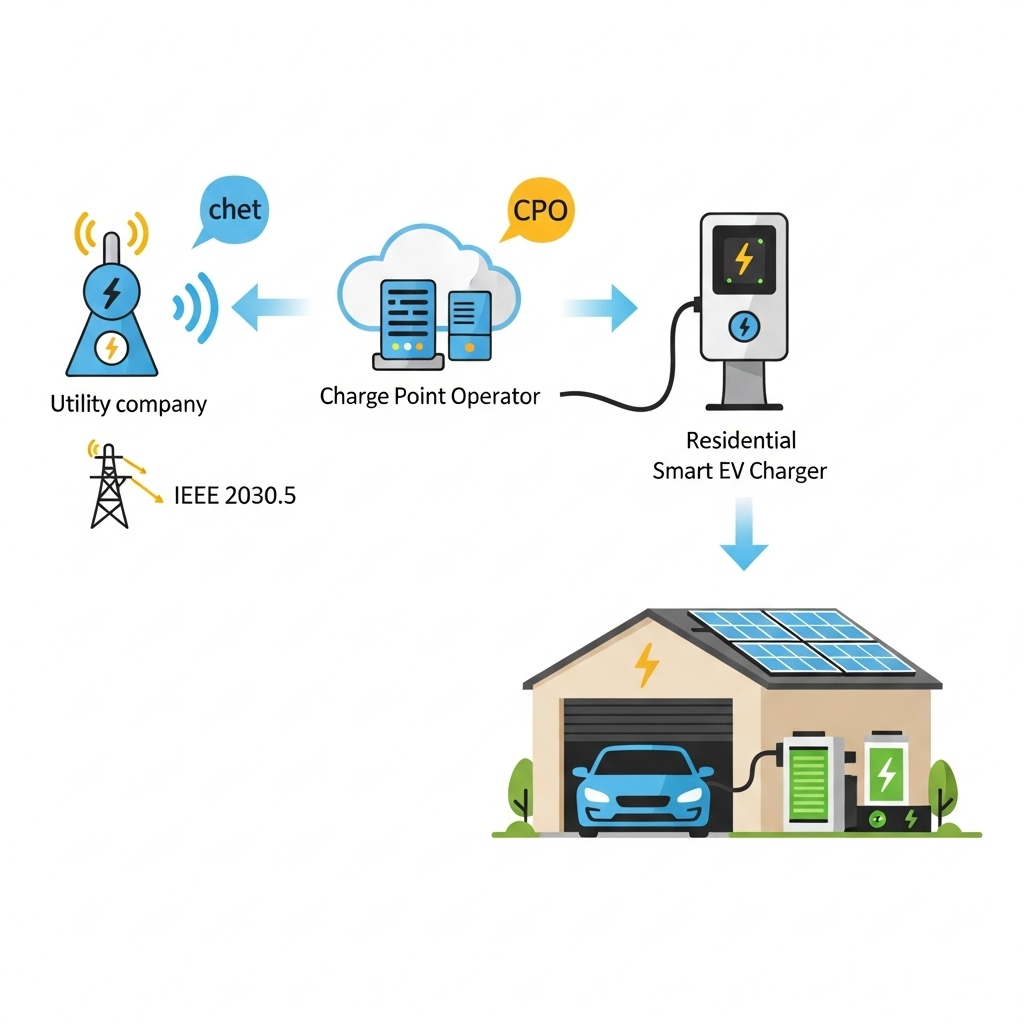As energy storage systems (ESS) become integral to our power infrastructure, securing their communication channels is no longer optional. Every inverter and battery system connected to a network is a potential entry point for cyber threats. The method used to authenticate and encrypt communications can determine the resilience of an entire fleet. Two common approaches are Pre-Shared Keys (PSK) and Public Key Infrastructure (PKI). While both aim to secure connections, their suitability for large-scale ESS deployments differs significantly.
Understanding Pre-Shared Keys (PSK) in ESS Communication
Pre-Shared Keys represent a straightforward method of symmetric encryption. Think of it as a shared secret password that two or more devices use to prove their identities to each other and encrypt their conversation.
How PSK Works: The Basics
In a PSK setup, a single key is manually configured on the inverter, the ESS, and any monitoring platform they communicate with. When these devices need to connect, they use this shared key to create a secure channel. This is similar to how you connect to your home's Wi-Fi network using a password. It's a simple, one-to-many security model that relies on keeping the shared secret safe.
Advantages and Limitations for Solar Installations
The primary advantage of PSK is its simplicity. For a small, isolated installation, like a single off-grid home with one inverter and one battery, setting up a PSK is quick and requires minimal computational resources. The overhead is low, making it an easy choice for basic setups. However, this simplicity quickly becomes a major liability as systems grow. Managing PSKs across dozens, hundreds, or thousands of distributed energy assets is a logistical and security nightmare. If a single key is compromised—whether through a disgruntled employee, a physical breach, or a weak key being cracked—every device using that key is instantly vulnerable. Securely rotating keys across a large fleet without service interruption is also exceptionally difficult, often leading to keys remaining unchanged for far too long.
The Role of Public Key Infrastructure (PKI) in Securing Inverters
Public Key Infrastructure offers a more robust and scalable solution. Instead of a shared secret, PKI uses a pair of mathematically linked keys for each device: a public key that can be shared openly and a private key that is never shared.
How PKI Establishes Trust
PKI operates on a principle of verifiable identity. Each device (like an inverter or ESS) is issued a unique digital certificate by a trusted third party known as a Certificate Authority (CA). This certificate is like a digital passport; it binds the device's public key to its identity. When two devices connect, they exchange certificates. Each device can then verify the other's certificate with the CA, confirming its identity without ever exposing its private key. This creates a chain of trust that is difficult to forge. The communication is then encrypted using these keys, ensuring both confidentiality and integrity.
Why PKI is Built for Scalability
PKI is designed from the ground up for large, distributed environments. Because each device has a unique identity, there are no shared secrets to protect. A central CA can manage the entire lifecycle of certificates for thousands or even millions of devices. It can issue, renew, and, most importantly, revoke certificates for specific devices that may be compromised or decommissioned. This ability to surgically remove a device from the trusted network is a critical security feature that PSK lacks. This aligns with the growing need for secure, real-time communication for distributed energy resources (DERs), a point emphasized in reports on grid modernization. According to the International Renewable Energy Agency's publication, Grid Codes for Renewable Powered Systems, effective communication is key for providing services like black-start capability in systems with high shares of DERs.
Head-to-Head Comparison: PKI vs. PSK for ESS Fleets
Choosing the right security framework requires a clear look at the trade-offs. For operators of multiple ESS assets, the differences in scalability and management are stark.
| Feature | Pre-Shared Keys (PSK) | Public Key Infrastructure (PKI) |
|---|---|---|
| Scalability | Low | High |
| Key Management | Difficult & Manual | Centralized & Automated |
| Security per Device | Low (Shared Risk) | High (Individual Identity) |
| Identity Revocation | Very Difficult / All or Nothing | Simple & Granular |
| Initial Setup Complexity | Low | Moderate to High |
| Operational Overhead | High at Scale | Low at Scale |
The Scalability Challenge
For a growing fleet of solar and storage assets, PSK does not scale. The operational burden of securely distributing and updating unique keys for each device is prohibitive. A single shared key across the fleet is a massive security risk. PKI, on the other hand, thrives at scale. Its centralized management model ensures that as your fleet grows, your security posture remains strong and manageable without a linear increase in administrative effort.
Security and Risk Management
With PSK, the compromise of one key can lead to a systemic failure. An attacker gaining the key could potentially control or spoof every device in that group. With PKI, the risk is isolated. If an attacker compromises a single inverter's private key, its certificate can be instantly revoked by the CA, cutting off its access to the network. This ability to detect and disconnect attacked assets is a core principle of modern grid security. A U.S. Department of Energy project highlighted this capability, where a multi-layered system could detect and disconnect attacked assets before they impact the system, a function enabled by strong, individual device identity.
Practical Implementation and Future-Proofing
The choice between PSK and PKI is a strategic one that impacts the long-term security and viability of your energy assets. While PSK has its niche, the future of grid-connected energy systems points clearly toward PKI.
When is PSK Still Acceptable?
PSK can be a reasonable choice for very small, static, and physically secure off-grid systems. For example, a remote cabin with a single inverter and battery that is not connected to the internet might use PSK effectively. Even in these cases, the key should be strong, unique to the site, and changed if there is any suspicion of compromise.
Building a Resilient System with PKI
For any grid-tied or large-scale deployment, PKI is the superior foundation. It not only secures communication but also enables other critical security functions like signed firmware updates and secure boot processes. As the IEA notes in The Power of Transformation, international cooperation on 'compatible and secure communication standards' is necessary to accelerate the adoption of smart grid technologies. PKI is the globally accepted standard for this. A robust security framework like PKI also directly supports the system's overall reliability. High-performing systems are secure systems, and this security is a key metric of quality. You can find more on the factors that constitute system quality in this ultimate reference on solar storage performance, which details how reliability and efficiency are measured.
Final Thoughts on Securing Your Energy Assets
While PSK offers simplicity for small-scale projects, it presents unacceptable risks and management challenges for modern, distributed ESS fleets. Public Key Infrastructure provides the scalable, granular, and manageable security framework necessary to protect critical energy infrastructure. Investing in a PKI-based security architecture is not just a technical decision; it is a strategic move to safeguard assets, ensure operational continuity, and build a resilient energy future.Disclaimer: This article provides general information and does not constitute professional cybersecurity advice. Always consult with a qualified cybersecurity expert to design and implement security solutions for your specific operational needs.
Frequently Asked Questions
What is the main difference between PKI and PSK?
PSK uses a single, shared secret (like a password) for all devices in a group to authenticate each other. PKI gives each device a unique digital identity (a certificate from a trusted authority), so there are no shared secrets.
Can I use both PKI and PSK?
While technically possible in some protocols, it's generally not recommended. It adds complexity without significant security benefits. The standard practice is to choose one method. PKI is the preferred choice for scalable and secure systems.
Is implementing PKI for my home ESS too complicated?
For a single homeowner, managing a full PKI might seem complex. However, many modern inverter and ESS manufacturers are building PKI-based security directly into their products. This simplifies the process for the end-user, who benefits from the enhanced security without needing to manage the infrastructure themselves.
How does PKI help with grid code compliance?
Modern grid codes increasingly demand robust cybersecurity and communication capabilities. As noted in reports from organizations like IRENA, secure communication is key for integrating distributed resources. PKI provides the verifiable, unique identity and encrypted communication channels that help system operators and asset owners meet these stringent compliance requirements.





Leave a comment
All comments are moderated before being published.
This site is protected by hCaptcha and the hCaptcha Privacy Policy and Terms of Service apply.